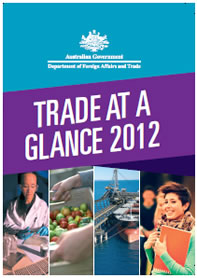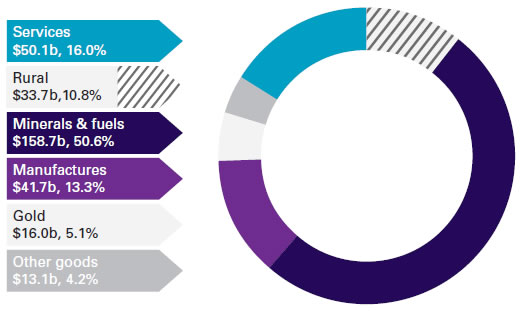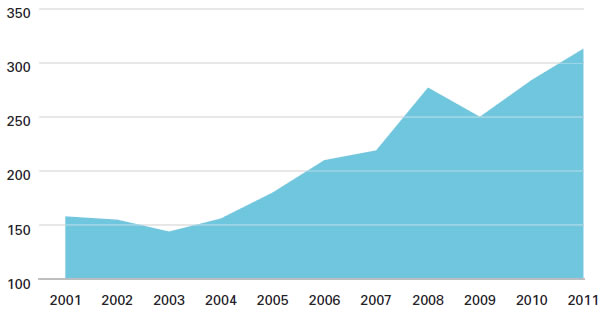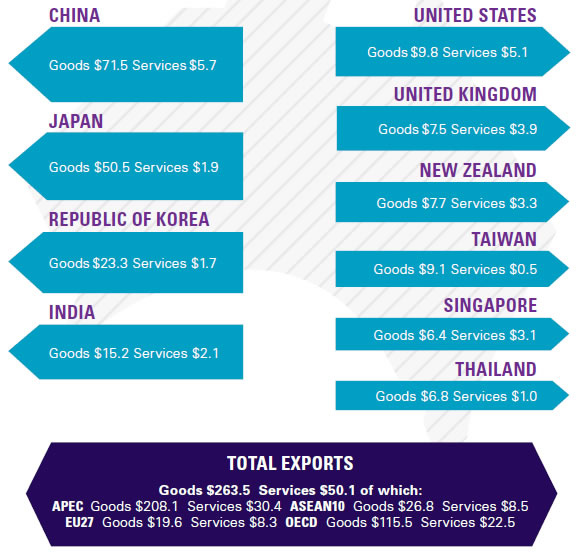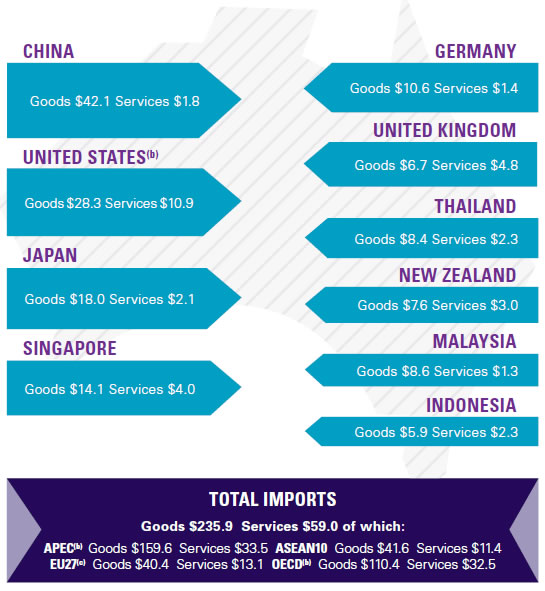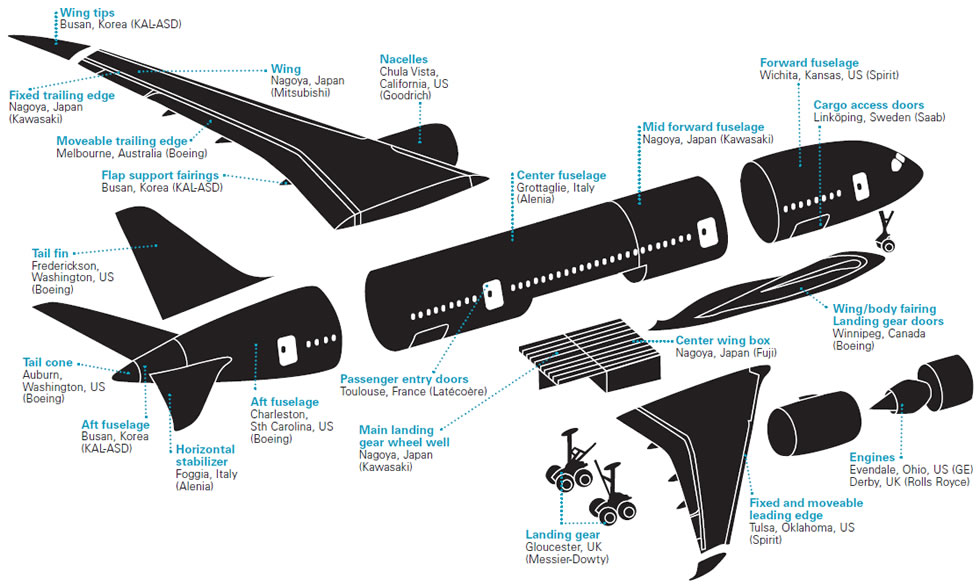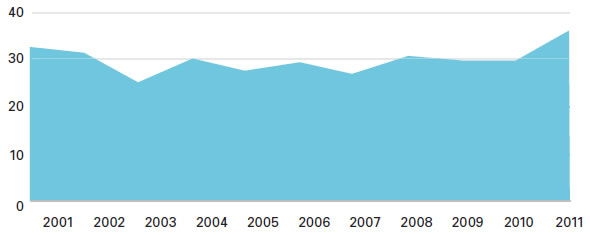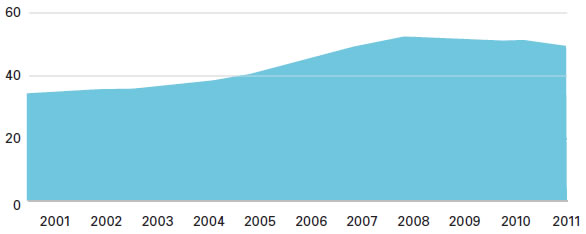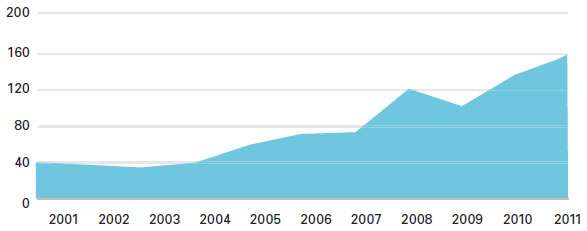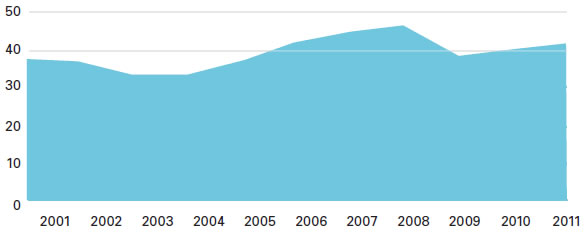ISSN 1839-1842 (Online)
ISBN 978-1-74322-062-7 (Web page)
ISBN 978-1-74322-061-0 (PDF document)
Print version
Contents
Trade Performance at a Glance
- Profile of Australia's Trade in 2011
- Australia's Trade Performance
- Australia's Trade and Economic Statistics
- The Australian Economy
- Feature: Global Value Chains
Trade Policy at a Glance
- Australia's Trade Policy
- Australia and the WTO
- Agricultural Trade
- Non-Agricultural Trade & Services Trade
- Minerals and Fuels
- Manufacturing
- Free Trade Agreements
- Australia and the G20
- Trade with our Region: APEC
- The Benefits of Foreign Investment
- Trade Liberalisation and Jobs
Trade at a Glance 2013 is due for release in October 2013
Profile of Australia's Trade in 2011
Australia's two-way trade reached a record $608.2 billion in 2011.
Minerals and fuels, especially iron ore and coal, played a vital role in Australia's economic success, making up over half of the nation's exports. Australia's total goods and services exports reached $313.3 billion.
Other leading exports included services such as education and tourism, manufactured goods (including pharmaceuticals and cars) and agricultural produce.
Imports are also integral to the success of the Australian economy, providing crucial inputs to domestic industries. Some key imports in 2011 included crude and refined petroleum, telecom equipment and computers.
China, Japan, the United States and the Republic of Korea were the nation's top four trading partners once again in 2011. Trade largely focused on the Asia-Pacific region, with over 70 per cent taking place with member economies of the Asia-Pacific Economic Cooperation (APEC) group.
Exports of goods and services 2011(a) Share of exports by sector
(a) Balance of payments basis. Based on ABS catalogue 5302.0.
Australia's Trade Performance in 2011
Australia's trade in goods and services reached a new high in 2011. Two-way trade grew by 9.9 per cent to $608.2 billion in 2011, up from $553.2 billion in 2010.
The value of Australia's exports grew 10.2 per cent to a new record of $313.3 billion. This was driven by strong demand and high prices received for Australia's metal ores, minerals and coal. Over the past year, the value of minerals exports increased by almost 25 per cent to $86.7 billion.
Australia's manufacturing exports also performed well in 2011, growing by three per cent to $41.7 billion, despite the challenges posed by the continuing strength of the Australian dollar.
Australia's record export performance resulted in an $18.3 billion trade surplus in 2011. This is an increase of $3.1 billion on the surplus recorded in 2010.
Exports of goods and services ($ billion) (a)
(a) Balance of payments basis. Based on ABS catalogue 5302.0.
Australia's Trade and Economic Statistics
| $ Billion | |
|---|---|
| Iron ore & concentrates | 64.1 |
| Coal | 46.8 |
| Gold(b) | 16.0 |
| Education-related travel services | 15.1 |
| Personal travel (excl education) services | 11.8 |
| Crude petroleum | 11.5 |
| Natural gas | 11.1 |
| Wheat | 6.1 |
| Aluminium ores & concentrates (incl alumina) | 5.4 |
| Copper ores & concentrates | 5.4 |
| Beef | 4.7 |
| Aluminium | 4.7 |
| Copper | 3.9 |
| Business travel services | 3.6 |
| Technical & other business services | 3.4 |
| Medicaments (incl veterinary) | 3.3 |
| Professional services | 3.2 |
| Refined petroleum | 2.9 |
| Wool & other animal hair (incl tops) | 2.8 |
| Passenger transport services(c) | 2.6 |
| Total exports(b) | 313.3 |
Based on ABS trade data on DFAT STARS database and ABS catalogue 5302.0. |
|
| Goods(a) | Services(b) | Total(c)(d) | % Share | ||
|---|---|---|---|---|---|
| 1 China | 113.6 | 7.4 | 121.1 | 19.9 | |
| 2 Japan | 68.4 | 4.0 | 72.5 | 11.9 | |
| 3 United States(e) | 38.1 | 16.1 | 54.2 | 8.9 | |
| 4 Republic of Korea | 30.4 | 2.2 | 32.7 | 5.4 | |
| 5 Singapore | 20.5 | 7.1 | 27.7 | 4.6 | |
| 6 United Kingdom | 14.3 | 8.7 | 23.0 | 3.8 | |
| 7 New Zealand | 15.3 | 6.3 | 21.6 | 3.5 | |
| 8 India | 17.5 | 2.9 | 20.3 | 3.3 | |
| 9 Thailand | 15.2 | 3.3 | 18.5 | 3.0 | |
| 10 Malaysia | 13.1 | 3.0 | 16.0 | 2.6 | |
| Total two-way trade(b) | 499.1 | 109.1 | 608.2 | 100.0 | |
| of which: | APEC(e) | 367.7 | 63.9 | 431.6 | 71.0 |
| ASEAN10 | 68.4 | 19.9 | 88.4 | 14.5 | |
| EU27(c) | 60.0 | 21.3 | 81.4 | 13.4 | |
| OECD(c)(e) | 225.9 | 55.0 | 280.9 | 46.2 | |
Based on ABS trade data on DFAT STARS database, ABS catalogues 5302.0. & 5368.0.55.004 and ABS unpublished data. |
|||||
| Goods (a) | $ Million | % Share |
|---|---|---|
| Crude petroleum | 20,830 | 8.8 |
| Refined petroleum | 14,305 | 6.1 |
| Passenger motor vehicles | 14,159 | 6.0 |
| Medicaments (incl veterinary) | 8,530 | 3.6 |
| Telecom equipment & parts | 8,322 | 3.5 |
| Computers | 6,634 | 2.8 |
| Goods vehicles | 6,153 | 2.6 |
| Gold(b) | 5,954 | 2.5 |
| Civil engineering equipment & parts | 4,257 | 1.8 |
| Furniture, mattresses & cushions | 2,780 | 1.2 |
| Rubber tyres, treads & tubes | 2,672 | 1.1 |
| Vehicle parts & accessories | 2,641 | 1.1 |
| Measuring & analysing instruments | 2,634 | 1.1 |
| Electrical machinery & parts | 2,508 | 1.1 |
| Prams, toys, games & sporting goods | 2,352 | 1.0 |
| Monitors, projectors & TVs | 2,290 | 1.0 |
| Heating & cooling equipment & parts | 2,173 | 0.9 |
| Electronic integrated circuits | 2,096 | 0.9 |
| Ships & boats (incl hovercraft) | 2,056 | 0.9 |
| Plastic articles | 2,042 | 0.9 |
| Total goods imports(c) | 235,932 | 100.0 |
Based on ABS trade data on DFAT STARS database and ABS catalogue 5302.0. |
||
| Goods(a) | $ million | % share |
|---|---|---|
| Iron ores & concentrates | 64,107 | 24.4 |
| Coal | 46,762 | 17.8 |
| Gold(b) | 15,971 | 6.1 |
| Crude petroleum | 11,451 | 4.4 |
| Natural gas | 11,084 | 4.2 |
| Wheat | 6,076 | 2.3 |
| Aluminium ores & concentrates (incl alumina) | 5,443 | 2.1 |
| Copper ores & concentrates | 5,441 | 2.1 |
| Beef | 4,684 | 1.8 |
| Aluminium | 4,656 | 1.8 |
| Copper | 3,853 | 1.5 |
| Medicaments (incl veterinary) | 3,278 | 1.2 |
| Refined petroleum | 2,938 | 1.1 |
| Wool & other animal hair (incl tops) | 2,837 | 1.1 |
| Cotton | 2,537 | 1.0 |
| Confidential mineral ores | 2,497 | 0.9 |
| Meat (excl beef) | 2,375 | 0.9 |
| Alcoholic beverages | 2,033 | 0.8 |
| Zinc ores & concentrates | 1,461 | 0.6 |
| Barley | 1,378 | 0.5 |
| Total goods exports(c) | 263,151 | 100.0 |
Based on ABS trade data on DFAT STARS database and ABS catalogue 5302.0. |
||
| Services | $ Million | % Share |
|---|---|---|
| Manufactured services on physical inputs owned by others | 1 | 0.0 |
| Maintenance & repair | 412 | 0.7 |
| Transport | ||
| Passenger(b) | 6,389 | 10.8 |
| Freight | 8,354 | 14.2 |
| Other(c) | 313 | 0.5 |
| Postal & courier services | 108 | 0.2 |
| Total transport | 15,164 | 25.7 |
| Travel | ||
| Business | 3,020 | 5.1 |
| Personal | 23,072 | 39.1 |
| > Education-related | 910 | 1.5 |
| > Other personal travel(d) | 22,162 | 37.6 |
| Total travel | 26,092 | 44.2 |
| Other | ||
| Construction | 0 | 0.0 |
| Insurance & pension | 577 | 1.0 |
| Financial | 867 | 1.5 |
| Intellectual property charges | 3,949 | 6.7 |
| Telecom, computer & information services | 1,902 | 3.2 |
| Other business services | 7,570 | 12.8 |
| Personal, cultural and recreational | 1,579 | 2.7 |
| Government services | 888 | 1.5 |
| Total other | 17,332 | 29.4 |
| Total services imports | 59,001 | 100.0 |
Based on ABS catalogue 5302.0. |
||
| Services | $ million | % share |
|---|---|---|
| Manufactured services on physical inputs owned by others | 26 | 0.1 |
| Maintenance & repair | 40 | 0.1 |
| Transport | ||
| Passenger(b) | 2,636 | 5.3 |
| Freight | 390 | 0.8 |
| Other(c) | 2,231 | 4.5 |
| Postal & courier services | 990 | 2.0 |
| Total transport | 6,247 | 12.5 |
| Travel | ||
| Business | 3,561 | 7.1 |
| Personal | 26,922 | 53.7 |
| > Education-related | 15,127 | 30.2 |
| > Other personal(d) | 11,795 | 23.5 |
| Total travel | 30,483 | 60.8 |
| Other | ||
| Construction | 74 | 0.1 |
| Insurance & pension | 405 | 0.8 |
| Financial | 1,356 | 2.7 |
| Intellectual property charges | 893 | 1.8 |
| Telecom, computer & information services | 1,686 | 3.4 |
| Other business services | 7,183 | 14.3 |
| Personal, cultural and recreational | 859 | 1.7 |
| Government services | 852 | 1.7 |
| Total other | 13,308 | 26.6 |
| Total services exports | 50,104 | 100.0 |
Based on ABS catalogue 5302.0. |
||
Australia's global export position
How we compare to the rest of the world 2011 (US $ billion)
| Rank | Country | Goods(a) | Services(b) | Total exports | % share |
|---|---|---|---|---|---|
| 1 | China | 1,899 | 183 | 2,081 | 9.3 |
| 2 | United States | 1,481 | 600 | 2,081 | 9.3 |
| 3 | Germany | 1,474 | 258 | 1,731 | 7.7 |
| 4 | Japan | 823 | 146 | 969 | 4.3 |
| 5 | Netherlands | 660 | 131 | 791 | 3.5 |
| 6 | France | 597 | 162 | 759 | 3.4 |
| 7 | United Kingdom | 473 | 278 | 751 | 3.4 |
| 8 | Republic of Korea | 555 | 95 | 650 | 2.9 |
| 9 | Italy | 523 | 108 | 631 | 2.8 |
| 10 | Russian Federation | 522 | 55 | 577 | 2.6 |
| 11 | Hong Kong(c) | 456 | 121 | 576 | 2.6 |
| 12 | Belgium | 476 | 88 | 564 | 2.5 |
| 13 | Singapore | 410 | 125 | 535 | 2.4 |
| 14 | Canada | 452 | 76 | 528 | 2.4 |
| 15 | India | 297 | 149 | 446 | 2.0 |
| 16 | Spain | 297 | 142 | 439 | 2.0 |
| 17 | Saudi Arabia | 365 | 13 | 377 | 1.7 |
| 18 | Mexico | 350 | 15 | 365 | 1.6 |
| 19 | Taiwan | 308 | 46 | 354 | 1.6 |
| 20 | Switzerland | 235 | 98 | 333 | 1.5 |
| 21 | Australia | 271 | 51 | 322 | 1.4 |
| 22 | United Arab Emirates | 285 | 14 | 299 | 1.3 |
| 23 | Brazil | 256 | 38 | 294 | 1.3 |
| 24 | Thailand | 229 | 41 | 270 | 1.2 |
| 25 | Sweden | 187 | 76 | 264 | 1.2 |
| 26 | Malaysia | 227 | 36 | 263 | 1.2 |
| 27 | Austria | 179 | 60 | 240 | 1.1 |
| 28 | Ireland | 127 | 108 | 235 | 1.0 |
| 29 | Poland | 187 | 37 | 224 | 1.0 |
| 30 | Indonesia | 201 | 21 | 222 | 1.0 |
| Total exports | 18,217 | 4,150 | 22,367 | ||
Source: WTO online database. |
|||||
Australia's top 10 export markets 2011 ($ billion)(a)
(a) Goods figures recorded trade basis; services figures balance of payments basis. Based on ABS trade data on DFAT STARS database and ABS catalogues 5302.0. and 5368.0.55.004.
Australia's global import position
How we compare to the rest of the world 2011 (US $ billion)
| Rank | Country | Goods(a) | Services(b) | Total imports | % share |
|---|---|---|---|---|---|
| 1 | United States | 2,265 | 412 | 2,677 | 12.0 |
| 2 | China | 1,743 | 238 | 1,981 | 8.9 |
| 3 | Germany | 1,254 | 285 | 1,539 | 6.9 |
| 4 | Japan | 854 | 167 | 1,021 | 4.6 |
| 5 | France | 715 | 142 | 856 | 3.8 |
| 6 | United Kingdom | 636 | 178 | 814 | 3.6 |
| 7 | Netherlands | 597 | 119 | 716 | 3.2 |
| 8 | Italy | 557 | 116 | 673 | 3.0 |
| 9 | Republic of Korea | 524 | 99 | 624 | 2.8 |
| 10 | India | 451 | 131 | 582 | 2.6 |
| 11 | Hong Kong(c) | 511 | 56 | 567 | 2.5 |
| 12 | Canada | 462 | 101 | 563 | 2.5 |
| 13 | Belgium | 461 | 82 | 543 | 2.4 |
| 14 | Singapore | 366 | 111 | 476 | 2.1 |
| 15 | Spain | 362 | 92 | 454 | 2.0 |
| 16 | Russian Federation | 323 | 92 | 415 | 1.9 |
| 17 | Mexico | 361 | 30 | 391 | 1.7 |
| 18 | Taiwan | 281 | 42 | 323 | 1.4 |
| 19 | Brazil | 237 | 76 | 313 | 1.4 |
| 20 | Australia | 244 | 60 | 304 | 1.4 |
| 21 | Thailand | 228 | 51 | 279 | 1.2 |
| 22 | Turkey | 241 | 21 | 262 | 1.2 |
| 23 | Switzerland | 208 | 47 | 255 | 1.1 |
| 24 | United Arab Emirates | 205 | 45 | 250 | 1.1 |
| 25 | Poland | 208 | 30 | 238 | 1.1 |
| 26 | Austria | 192 | 45 | 236 | 1.1 |
| 27 | Sweden | 175 | 56 | 231 | 1.0 |
| 28 | Malaysia | 188 | 38 | 225 | 1.0 |
| 29 | Indonesia | 176 | 32 | 209 | 0.9 |
| 30 | Saudi Arabia | 112 | 78 | 190 | 0.9 |
| Total imports | 18,381 | 3,974 | 22,355 | ||
Source: WTO online database. |
|||||
Australia's top 10 import sources 2011 ($ billion)(a)
(a) Goods figures recorded trade basis; services figures balance of payments basis.
(b) Based on unpublished ABS data and includes confidential aircraft imports for the US only.
(c) Excludes imports of aircraft from regional import totals from Sep-08 onwards (excl the US - see (b))
| Country | Level of direct investment in Australia | Level of total investment in Australia | |
|---|---|---|---|
| United States | 122,379 | 555,868 | |
| United Kingdom | 69,747 | 470,846 | |
| Japan | 52,334 | 123,410 | |
| Singapore | 19,966 | 48,709 | |
| Netherlands | 32,870 | 43,706 | |
| Switzerland | 23,005 | 42,281 | |
| Hong Kong(b) | 6,714 | 39,416 | |
| New Zealand | 5,980 | 29,707 | |
| Canada | 17,326 | 25,048 | |
| Luxembourg | 2,344 | 23,542 | |
| Total all countries | 507,360 | 2,030,032 | |
| Of which: | APEC | 249,764 | 891,925 |
| ASEAN10 | 27,724 | 79,263 | |
| EU27 | 143,434 | 637,176 | |
| OECD | 367,790 | 1,420,183 | |
Source: ABS catalogue 5352.0. |
|||
| Country | Level of direct investment abroad | Total Australian investment abroad | |
|---|---|---|---|
| United States | 97,854 | 410,612 | |
| United Kingdom | 52,105 | 192,944 | |
| New Zealand | 40,159 | 74,267 | |
| Canada | 23,295 | 43,476 | |
| Germany | 7,394 | 36,260 | |
| Japan | 281 | 34,595 | |
| France | 491 | 27,245 | |
| Netherlands | 4,598 | 26,875 | |
| Singapore | 7,061 | 21,350 | |
| Hong Kong (b) | 3,865 | 20,386 | |
| Total all countries | 338,934 | 1,175,380 | |
| Of which: | APEC | 209,176 | 676,904 |
| ASEAN10 | 17,801 | 41,826 | |
| EU27 | 75,705 | 356,141 | |
| OECD | 247,671 | 929,597 | |
Source: ABS catalogue 5352.0. |
|||
The Australian Economy
The Australian economy remains one of the strongest developed economies in the world. While most other advanced economies are struggling, Australia has grown by about 10 per cent since the start of the Global Financial Crisis. In 2011 Australia's economic growth was 2.2 per cent and the average unemployment rate was one of the lowest in the Organisation for Economic Co-operation and Development (OECD) at 5.1 per cent. Despite continuing international uncertainty, Australia's economic prospects remain positive, with low public debt, low unemployment, contained inflation and continuing strong business investment.
The strong performance of the Australian economy is due to a number of factors, including:
- the Government's responsible fiscal management, with a commitment to deliver a budget surplus for the 2012-13 financial year;
- robust economic institutions, in particular a strong and independent financial sector and an effective regulatory system – four of the world's nine most highly rated banks are Australian;
- a flexible and open trade and investment environment, supported by well-targeted economic policies encouraging business growth and innovation;
- a business-friendly regulatory environment, making Australia a cost competitive place for businesses to locate their operations; and
- strong trade and economic links with the emerging economies of Asia, the powerhouse of global economic growth, helping to support growth and employment in Australia.
On 1 July 2012, the Government introduced two structural reforms to ensure continued economic success: the Mineral Resource Rent Tax (MRRT) and carbon pricing. The MRRT will help to spread the benefits of the Australian mining boom across the economy. Carbon pricing will create incentives for business to invest in clean technology or find less energy-intensive ways of operating. This will enable the economy to adapt to a clean energy future, while sustaining strong economic growth.
| Gross value added(a) | Employed persons(b) | |||
|---|---|---|---|---|
| $m | % share(c) | '000 | % share | |
| Agriculture, forestry & fishing | 29,901 | 2.4 | 328.1 | 2.9 |
| Mining | 98,666 | 7.9 | 222.7 | 1.9 |
| Manufacturing | 105,877 | 8.5 | 967.6 | 8.5 |
| Services | 906,554 | 72.6 | 9,880.5 | 86.4 |
| Electricity, gas, water & waste | 28,672 | 2.3 | 151.6 | 1.3 |
| Construction | 104,914 | 8.4 | 1,037.7 | 9.1 |
| Wholesale trade | 56,501 | 4.5 | 418.4 | 3.7 |
| Retail trade | 59,139 | 4.7 | 1,231.4 | 10.8 |
| Accommodation & food services | 30,663 | 2.5 | 785.2 | 6.9 |
| Transport, postal & warehousing | 68,478 | 5.5 | 585.4 | 5.1 |
| Information, media & telecommunications | 42,709 | 3.4 | 210.1 | 1.8 |
| Finance & insurance | 129,757 | 10.4 | 423.6 | 3.7 |
| Rental, hiring & real estate | 26,841 | 2.2 | 199.1 | 1.7 |
| Professional, scientific & technical |
87,769 | 7.0 | 870.3 | 7.6 |
| Administrative & support | 31,369 | 2.5 | 403.3 | 3.5 |
| Public administration & safety | 66,726 | 5.3 | 723.7 | 6.3 |
| Education & training | 59,516 | 4.8 | 858.9 | 7.5 |
| Health care & social assistance | 79,081 | 6.3 | 1,317.4 | 11.5 |
| Arts & recreation | 11,552 | 0.9 | 212.2 | 1.9 |
| Other services | 22,867 | 1.8 | 452.5 | 4.0 |
| Ownership of dwellings | 107,412 | 8.6 | ||
| Gross value added at basic prices(d) | 1,248,413 | 100.0 | ||
| Taxes less subsidies on products | 91,295 | |||
| Statistical discrepancy(e) | -4,407 | |||
| Total(d) | 1,335,303 | 11,436 | 100.0 | |
Based on ABS catalogues 5206.0, 6202.0 and 6203.0. |
||||
| 2001 | 2009 | 2010 | 2011 | ||
|---|---|---|---|---|---|
| Demand and production - chain volume measures, reference year 2009-10 | |||||
| Gross domestic product(a) | % change | 2.8 | 1.5 | 2.4 | 2.2 |
| Exports of goods & services(a) | % change | 2.8 | 2.4 | 5.4 | -1.3 |
| Imports of goods & services(a) | % change | -4.5 | -8.6 | 14.3 | 11.2 |
| Labour force | |||||
| Population(b) | '000 | 19,534 | 21,929 | 22,183 | 22,485 |
| Labour force | '000 | 9,746 | 11,602 | 11,868 | 12,050 |
| Employed persons | '000 | 9,088 | 10,953 | 11,247 | 11,435 |
| – Annual growth | % | 1.1 | 0.7 | 2.7 | 1.7 |
| Unemployment rate | % | 6.8 | 5.6 | 5.2 | 5.1 |
| Prices and interest rates | |||||
| Consumer prices | % change | 3.1 | 2.1 | 2.7 | 3.1 |
| Interest rates - 90 day bills(c) | % pa | 4.9 | 3.4 | 4.7 | 4.8 |
Based on Australian Bureau of Statistics and Reserve Bank, various catalogues. |
|||||
Global Value Chains
Have you ever considered how a modern plane is constructed? The new Boeing 787 Dreamliner is assembled in the United States using components built around the world. The centre fuselage is from Italy, the mid-forward fuselage is from Japan, the Rolls Royce engines are from the United Kingdom and a vital wing component - the moveable trailing edge - is designed and produced in Melbourne at Boeing Aerospace Australia. Bringing all these parts together to build a Boeing 787 Dreamliner is an example of a global value chain (GVC) in action.
A 'value chain' is the full range of activities involved in designing, producing and delivering a good or service. The nature of trade has transformed in recent decades with value chains becoming 'global' and activities divided across borders. The OECD estimates that more than half of the value of world exports today relates to products traded as part of GVCs.
Value chains have become 'global' for a number of reasons, including:
- information technology changes, particularly in communications;
- differences in costs of production between countries (eg. Asia's cost advantage in manufacturing);
- lower trade and transport costs, making it relatively cheap to bring components from all around the world to make a single product; and
- better international logistics, allowing companies to manage these complex GVCs.
The Importance of GVCs in Trade Today
The growing importance of GVCs has further increased the incentive for countries to cut barriers to trade. This is because most industries now source their inputs to production from every corner of the globe, as part of GVCs. This means that tariffs and import restrictions will impact the competitiveness of a country's local industries, as this would make imported inputs more expensive.
Active involvement in GVCs brings great benefits to Australia, as seen in the example of the Boeing 787 Dreamliner. This is Australia's largest aerospace contract to date, worth approximately $4 billion over 20 years, and it has secured high-quality jobs for Australians. So that Australia can continue to be a successful trading nation into the future, we need to keep up our trade-related reform and efforts to enhance the competitiveness of our economy. This will allow Australia to integrate further with GVCs, leading to greater levels of economic growth and employment.
Partners Across the globe are bringing the 787 together
Australia's Trade Policy
Trading our way to more jobs and prosperity
The Government's vision for the nation is of a prosperous, innovative and sustainable Australia, providing opportunity for all. International trade contributes to the fulfilment of that vision by increasing productivity and international competitiveness, creating a high-skill, high-wage workforce and building national prosperity.
With these objectives in mind, the Government's trade policy statement, Trading our way to more jobs and prosperity, released by the Minister for Trade and Competitiveness Dr Craig Emerson on 12 April 2011, sets out five guiding principles:
- unilateralism – a commitment to the pursuit of ongoing, trade-related economic reform without waiting for other countries to reform their own economies;
- non-discrimination – Australia will not seek exclusive or entrenched preferential access to other countries' markets;
- separation – foreign policy considerations will not override trade policy assessments in determining the choice of negotiating partners and consideration of proposed trade deals;
- transparency – the public will be kept well informed about the progress of trade negotiations and will have the opportunity to provide input; and
- the indivisibility of trade policy and wider economic reform – domestic economic reform, improved international competitiveness and increased market access work together to create jobs and prosperity.
Consistent with these principles the Government will continue to pursue improved market access for Australian exporters in global markets. The number one priority is to achieve multilateral trade outcomes through the World Trade Organization (WTO). At the regional level, the Government will continue to pursue trade liberalisation through APEC and other regional trade arrangements. The Government will also pursue high-quality, comprehensive bilateral free trade agreements, where these will benefit both Australia and our trading partners.
Australia and the WTO
As a founding member of both the WTO in 1995 and its predecessor, the General Agreement on Tariffs and Trade in 1947, Australia has a longstanding commitment to the multilateral trading system operated by the WTO. This system provides the framework governing world trade. Members agree on legally binding rules that provide important certainty for their exporters. Members can use the WTO's dispute settlement system to uphold these rules.
Australia also works actively to maintain these rules through participation in WTO committees. The committees provide the opportunity to discuss trade issues amongst WTO members. They also enhance transparency by requiring WTO members to notify them of measures they intend introducing that could affect trade.
Australia is deeply committed to opening markets through multilateral trade negotiations in the WTO. Through such negotiations – including the current Doha Round of trade negotiations – Australia seeks market access for Australian exports across various negotiating sectors, including agriculture, industrial goods and services.
Agricultural Trade
The Australian Government is committed to the WTO agriculture negotiations, as this sector remains one of the most highly protected. Positive outcomes in these negotiations will be of great benefit as Australia exports around 60 per cent of its agricultural production. In the WTO agriculture negotiations, Australia's key objectives are to achieve a substantial improvement in market access; deep cuts to trade-distorting farm subsidies; and the elimination of all forms of agricultural export subsidies. Our active engagement in the WTO committee process, together with our involvement in WTO disputes, helps ensure that other countries are abiding by the existing trade rules for agriculture.
Australia is chair of the WTO Cairns Group coalition of 19 agricultural exporting countries. The Cairns Group brings together a diverse range of developed and developing countries from Latin America, Africa and the Asia-Pacific region, and has been an influential voice in the agricultural reform debate since its formation in 1986.
Members of the Cairns Group
- Argentina
- Australia
- Bolivia
- Brazil
- Canada
- Chile
- Colombia
- Costa Rica
- Guatemala
- Indonesia
- Malaysia
- New Zealand
- Pakistan
- Paraguay
- Peru
- The Philippines
- South Africa
- Thailand
- Uraguay
Australia's agricultural exports ($ billion)
| Rank | Commodity (b) | $ million | % share |
|---|---|---|---|
| 1 | Wheat | 6,076 | 16.3 |
| 2 | Beef | 4,684 | 12.6 |
| 3 | Wool & other animal hair (incl tops) | 2,837 | 7.6 |
| 4 | Cotton | 2,537 | 6.8 |
| 5 | Meat (excl beef) | 2,375 | 6.4 |
| 6 | Wine | 1,922 | 5.2 |
| 7 | Sugars, molasses & honey | 1,428 | 3.8 |
| 8 | Barley | 1,378 | 3.7 |
| 9 | Oil-seeds & oleaginous fruits, soft | 1,287 | 3.4 |
| 10 | Milk, cream, whey & yoghurt | 1,210 | 3.2 |
| 11 | Animal feed | 1,074 | 2.9 |
| 12 | Live animals (excl seafood) | 1,071 | 2.9 |
| 13 | Vegetables | 959 | 2.6 |
| 14 | Hides & skins, raw (excl furskins) | 850 | 2.3 |
| 15 | Edible products & preparations | 788 | 2.1 |
| 16 | Wood in chips or particles | 775 | 2.1 |
| 17 | Cheese & curd | 754 | 2.0 |
| 18 | Crustaceans | 683 | 1.8 |
| 19 | Cereal preparations | 640 | 1.7 |
| 20 | Fruit & nuts | 534 | 1.4 |
| Total agricultural exports | 37,319 | 100.0 | |
Based on ABS trade data on DFAT STARS database; ABS Special Data Service. |
|||
Non-Agricultural Trade
Non-agricultural trade (which includes industrial, forestry and seafood products) accounts for around 90 per cent of global trade in goods.
The Australian Government is actively involved in relevant WTO committees, such as the Technical Barriers to Trade Committee and the Import Licensing Committee, to address non-tariff barriers to trade in non-agricultural goods.
Australia is committed to playing a leadership role in launching negotiations to expand the product coverage and membership of the WTO Information Technology Agreement, in order to build on the contribution this Agreement has made to promoting trade and investment and driving innovation.
Trade Facilitation
The Australian Government is working towards the early conclusion of an ambitious WTO trade facilitation agreement. Trade facilitation negotiations are directed at expediting the movement, release and clearance of goods, including goods in transit.
Studies by the OECD, World Bank and European Union have shown there would be significant gains to world trade from a trade facilitation agreement, with the majority of these benefits accruing to developing and least developed countries.
Intellectual Property
Australia is a trading nation with a strong research tradition and a need for access to new technologies. Trade in royalties for intellectual property for Australia in 2011 was $1.1 billion (exports) and $5.2 billion (imports). The Government supports Australia's innovative industries and exporters by negotiating balanced international arrangements for the protection and use of intellectual property.
Services Trade
The Government is working hard to achieve better access for Australia's services exports. Australia is playing a leading role in promoting services trade through the WTO as well as by expanding market access for our services exports through comprehensive free trade agreements. The Government continues to look for ways to broaden existing liberalisation efforts and build on those efforts in a multilateral setting.
In particular, the Government is aiming to liberalise foreign equity caps on overseas investments, improve regulatory transparency, and make it easier for business people to pursue opportunities in foreign markets through improved business mobility.
Priority sectors include financial services, telecommunications, professional services, education, mining-related services and environmental services.
Australia is also active in promoting regulatory reform and services market access through APEC. In 2011 Australia led efforts to facilitate services trade through the APEC Accounting Services Initiative. Australia also sponsored the APEC Services Trade Access Requirements (STAR) Database. This business-friendly online resource has become a vital tool for services exporters in Australia and across the APEC region.
Australia's Services exports ($ billion)
Based on ABS catalogue 5302.0.
| Rank | Commodity(a) | $ million | % share |
|---|---|---|---|
| 1 | Iron ores & concentrates | 64,107 | 40.4 |
| 2 | Coal | 46,762 | 29.5 |
| 3 | Crude petroleum | 11,451 | 7.2 |
| 4 | Natural gas | 11,084 | 7.0 |
| 5 | Aluminium ores & conc (incl alumina) | 5,443 | 3.4 |
| 6 | Copper ores & concentrates | 5,441 | 3.4 |
| 7 | Other ores & concentrates | 4,556 | 2.9 |
| 8 | Refined petroleum | 2,938 | 1.9 |
| 9 | Confidential mineral ores | 2,497 | 1.6 |
| 10 | Nickel ores & concentrates | 1,241 | 0.8 |
| 11 | Precious metal ores & conc (excl gold) | 1,194 | 0.8 |
| 12 | Liquefied propane & butane | 962 | 0.6 |
| 13 | Non-ferrous waste & scrap | 926 | 0.6 |
| 14 | Ferrous waste & scrap | 867 | 0.5 |
| 15 | Crude minerals | 271 | 0.2 |
| 16 | Coke & semi-coke | 255 | 0.2 |
| 17 | Stone, sand & gravel | 102 | 0.1 |
| 18 | Natural abrasives | 38 | 0.0 |
| 19 | Residual petroleum products | 9 | 0.0 |
| 20 | Crude fertilisers | 4 | 0.0 |
| Total minerals & fuels exports(b) | 158,657 | 100.0 | |
|
(a) Recorded trade basis. (b) Total minerals and fuels exports on a balance of payments basis. Based on ABS trade data on DFAT STARS database and ABS catalogue 5302.0. |
|||
Australia's minerals and fuels exports ($ billion)
Based on ABS catalogue 5302.0.
| Rank | Commodity(a) | $ million | % share |
|---|---|---|---|
| 1 | Aluminium | 4,656 | 11.2 |
| 2 | Copper | 3,853 | 9.2 |
| 3 | Medicaments (incl veterinary) | 3,278 | 7.9 |
| 4 | Passenger motor vehicles | 1,352 | 3.2 |
| 5 | Aircraft, spacecraft & parts | 1,099 | 2.6 |
| 6 | Measuring & analysing instruments | 993 | 2.4 |
| 7 | Zinc | 968 | 2.3 |
| 8 | Lead | 929 | 2.2 |
| 9 | Medical instruments (incl veterinary) | 908 | 2.2 |
| 10 | Telecom equipment & parts | 892 | 2.1 |
| 11 | Civil engineering equipment & parts | 858 | 2.1 |
| 12 | Specialised machinery & parts | 812 | 1.9 |
| 13 | Uncoated flat-rolled iron & steel | 775 | 1.9 |
| 14 | Pigments, paints & varnishes | 757 | 1.8 |
| 15 | Vehicle parts & accessories | 732 | 1.8 |
| 16 | Paper & paperboard | 685 | 1.6 |
| 17 | Nickel | 647 | 1.6 |
| 18 | Jewellery | 615 | 1.5 |
| 19 | Misc manufactured articles | 613 | 1.5 |
| 20 | Computer parts & accessories | 608 | 1.5 |
| Total manufactures exports(b) | 41,663 | 100.0 | |
Based on ABS trade data on DFAT STARS database and ABS catalogue 5302.0. |
|||
Australia's manufactures exports ($ billion)
Based on ABS catalogue 5302.0.
Free Trade Agreements
The Government is pursuing WTO-consistent, high-quality, comprehensive free trade agreements (FTAs) with key trading partners, where they offer net benefits to Australia and are supportive of global trade liberalisation.
Australia has concluded seven FTAs:
- Malaysia-Australia Free Trade Agreement (MAFTA) 2012 (subject to domestic approval processes)
- ASEAN-Australia-New Zealand Free Trade Agreement (AANZFTA) 2010
- Australia-Chile Free Trade Agreement (AClFTA) 2009
- Australia-United States Free Trade Agreement (AUSFTA) 2005
- Thailand-Australia Free Trade Agreement (TAFTA) 2005
- Singapore-Australia Free Trade Agreement (SAFTA) 2003
- Australia-New Zealand Closer Economic Relations Trade Agreement (ANZCERTA) 1983
Australia is undertaking FTA negotiations with:
- China
- The Gulf Cooperation Council (Saudi Arabia, Qatar, Bahrain, Oman, Kuwait, United Arab Emirates)
- India
- Indonesia
- Japan
- Republic of Korea
- Trans-Pacific Partnership members (Brunei Darussalam, Canada, Chile, Malaysia, Mexico, New Zealand, Peru, Singapore, USA, Vietnam)
Australia's Free Trade Agreements should:
- be fully consistent with WTO principles and rules, deliver WTO-plus outcomes and reinforce the multilateral trading system;
- be comprehensive and genuinely liberalising, eliminating or substantially reducing barriers to goods and services trade and investment;
- deliver a substantial net economic benefit to Australia;
- be negotiated in a way that ensures the public is well informed about trade negotiations and has an opportunity for input;
- avoid entrenching preferential market access, while ensuring that Australian exporters and investors have an opportunity to compete on terms as favorable as anyone else's; and
- not delay domestic economic reform.
For more information on Australia's FTAs visit: www.fta.gov.au
Australia and the G20
Australia is a founding member of the Group of Twenty (G20), the premier forum for international economic cooperation. The G20 consists of 19 countries and the European Union.
The G20 played a key role in responding to the global financial crisis of 2008-2009, helping to avert a global depression. The decisive and coordinated actions of the G20 boosted consumer and business confidence and supported the first signs of economic recovery.
Recently, the focus of the G20 has shifted towards addressing new vulnerabilities to the global economy arising from the Eurozone sovereign debt crisis. Mexico is the current chair of the G20, and hosted the G20 Leaders' Summit in Los Cabos in June 2012.
Following Russia's host year in 2013, Australia will host the G20 in 2014. This will give Australia the opportunity to continue to pursue its agenda of restoring global economic growth and jobs, pressing for further trade liberalisation and achieving global sustainable development. Australia is committed to consulting non-G20 members so that their views are considered and G20 decisions can benefit all economies.
G20 members
- Argentina
- Australia
- Brazil
- Canada
- China
- European Union
- France
- Germany
- India
- Indonesia
- Italy
- Japan
- Mexico
- Republic of Korea
- Saudi Arabia
- Russian Federation
- South Africa
- Turkey
- United Kingdom
- United States
G20 countries make up:
- 87 per cent of global GDP
- 65 per cent of world population
- 77 per cent of world trade
Trade with our region: APEC
As the leading economic forum in the Asia-Pacific, APEC has delivered substantial gains for businesses and consumers alike both in Australia and throughout the region. APEC is pursuing an ambitious agenda of trade liberalisation, business facilitation, and economic cooperation and technical assistance. The private sector engages closely with the APEC process, particularly through the APEC Business Advisory Council.
The Russian Federation is the current APEC host, with Indonesia to take over the role in 2013 and China in 2014.
- APEC's goal is to achieve free and open trade and investment in the region by 2020.
- Since 1989, average applied tariffs in the APEC region have fallen from 16.9 to 5.8 per cent.
- Eight of Australia's 10 largest export markets are within APEC, including our top three export markets – China, Japan and the Republic of Korea.
- APEC has 21 member economies which account for 44 per cent of world trade and 71 per cent of Australia's total trade.
- Most recent APEC achievements include an agreement on a list of environmental goods for tariff reduction by 2015, as well as a new program of work on higher education cooperation.
Members of APEC
- Australia
- Brunei Darussalam
- Canada
- Chile
- People's Republic of China
- Hong Kong China
- Indonesia
- Japan
- Republic of Korea
- Malaysia
- Mexico
- New Zealand
- Papua New Guinea
- Peru
- The Philippines
- Russian Federation
- Singapore
- Chinese Taipei
- Thailand
- United States
- Vietnam
For more information on APEC: www.apec.org
The Benefits of Foreign Investment
Foreign investment has allowed Australians to enjoy higher rates of economic growth, employment and living standards than could have been achieved from domestic savings alone. This is because it:
- supplements scarce domestic savings – due to Australia's relatively small population, foreign investment has provided access to needed capital;
- allows access to new technologies – foreign companies often transfer technology to Australia when they invest, making us more internationally competitive;
- creates new businesses and employment – foreign companies setting up subsidiaries in Australia create jobs, leading to economic growth;
- provides revenue to the government – profits of foreign-owned companies are taxed, spreading the benefits of these investments to all Australians; and
- helps to drive productivity growth – it provides access to new technologies and increases the level of competition in the market.
A number of studies have examined the impact of foreign investment. In 2010 a study by Access Economics found that a 10 per cent increase in foreign investment in Australia would lead to a more than one per cent increase in GDP by 2020. An OECD study found that increasing foreign investment as a share of GDP is significantly and positively associated with productivity growth.
Trade Liberalisation and Jobs
Trade liberalisation has been at the heart of Australian Government policy for the past 30 years. Australia now has limited tariff and import restrictions on most of our traded goods sectors and low barriers to most services trade - initiatives that have bolstered the strength of our economy.
This process has opened the economy to greater volumes of trade, increasing productivity, accelerating economic growth and making the economy more flexible and dynamic. Australia's economic strength and resilience during the recent global economic turbulence was in part a result of Australia's trade liberalisation reforms.
The OECD's International Collaborative Initiative on Trade and Employment (ICITE) recently published a report on the relationship between trade and jobs. It found that trade creates jobs, increases real incomes and enhances productivity.
The ICITE determined that more liberalised economies most notably out-performed closed economies in terms of pay. Workers in the manufacturing sector of liberal economies benefitted from pay rates that were between three and nine times greater (depending on the region) than in closed economies. Besides driving wages up, trade also positively affects incomes by lowering prices of goods and services because of increased competitive pressures.
These benefits of liberalisation have occurred in Australia. A Centre for International Economics study determined that there has been an increase in real income of up to $3,900 per year for the average Australian family due to the trade liberalisation agenda since 1988. The study also found that, in Australia alone, over 2 million jobs in today's workforce are related to trade, further illustrating the importance of trade liberalisation for Australia.

